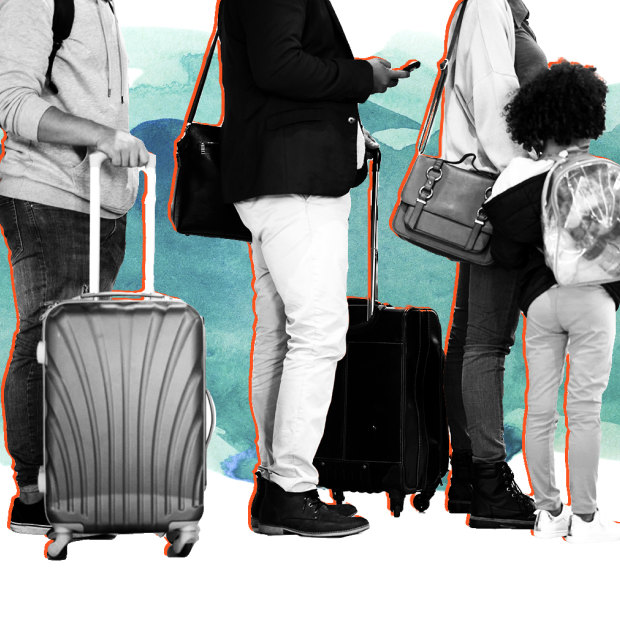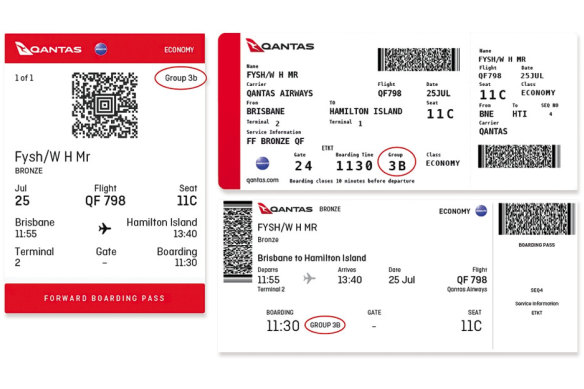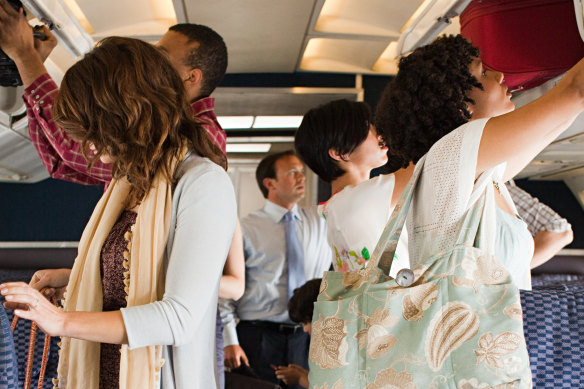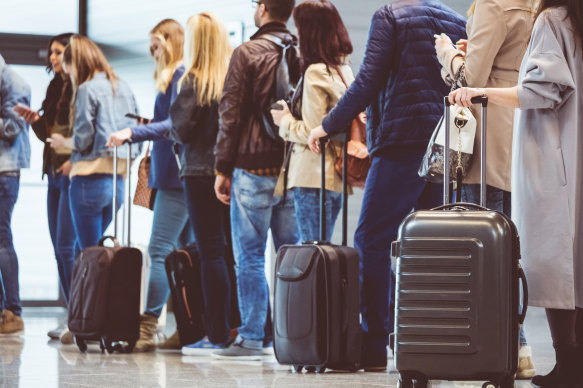Explainer
- Explainer
- Air travel
What’s the fastest way to board passengers on a plane?
And what about getting off at the other end? Astrophysicists and mathematicians have turned their minds to the question.
Fly Qantas in the next few months and you might find yourself corralled into an experiment. Until now, Australian domestic airlines have largely used similar commonsense methods of getting passengers onto their planes – boarding from the back to the front, or in one random go or simultaneously from the back and front doors. All tend to result in shuffling queues. Yet research studies and computer simulations have consistently shown there are better ways.
So Qantas is now trialling a system – initially out of Brisbane – that, while not new to flyers overseas, is quite a departure from what we’re used to domestically. It promises to cut down queuing and speed up aircraft “turnarounds” – time spent at the gate – and, we can only hope, make it more likely the planes will depart on time. In June, nearly a third of Qantas and Virgin flights were late getting off the ground.
So what is the Brisbane experiment? Why are boarding procedures so critical? Why do passengers stand to queue at the gate even before it opens? And what does Albert Einstein have to do with it?

Credit: Getty Images, Fairfax
What problem is Qantas trying to solve?
The quicker you get everybody on board, the better it is both for passengers – who can get to their seats and finally relax – and the airline, which wants its planes in the air making money and not stuck at the gate. Studies suggest even shaving a minute from the turnaround time – that eon spent refuelling, loading, cleaning and boarding – can save, or make, airlines millions of dollars a year. Meanwhile, departure delays obviously annoy passengers and can cost airlines money, especially if they occur early in the day and cascade onwards in a blitz of ruined schedules and missed connections.
Arrivals and departures are scheduled months in advance, explains Cheng-Lung Wu, an associate professor at UNSW Aviation who specialises in airline operations management. “The challenge is that if the aircraft arrives late and you don’t have too much flexibility buffer time within the turnaround time, then the aircraft is almost guaranteed to leave late, which creates a domino effect for all the flights conducted by this aircraft.”
None of Australia’s domestic airlines have covered themselves in glory this year: according to the Bureau of Infrastructure, Transport and Regional Economics, the number of on-time arrivals and departures for June across Qantas, Jetstar, Rex, Skytrans and Virgin were “significantly lower” than the long-term average performance. Qantas-only departures were 66.1 per cent on time (within 15 minutes of schedule) for June, slightly worse than Virgin-only departures at 67.9 per cent.
Qantas aims for an 80 per cent on-time departure rate, not 100 per cent. Why? “Several factors can impact on-time performance, including things that are and are not in the airline’s control,” says Mike Stengel of the US-based aerospace consulting firm AeroDynamic Advisory. “Weather, maintenance, catering, crew availability, the availability of the inbound aircraft, baggage handling, et cetera. The list is endless.” Achieving a perfect record is virtually impossible, he says. “Many airlines won’t even prioritise on-time departures as a metric and instead more heavily focus on achieving on-time arrivals because they can pad their schedules and try to make up time in the air if a flight leaves late.”
Strong westerlies in Sydney can mean the only runway available is the main east-west one rather than the pair of north-south runways, which can lead to delays across the country.
Overall, the Qantas network (including Qantas Link) did better than the Virgin network (including Virgin’s regional airline), but at 71.4 per cent for on-time departures was still way down on the long-term all-airline average of 82.5 per cent. Qantas says ground crew shortages were a factor along with the weather on 19 days out of 30 at major airports.
Yes: wind matters. Since it’s far better for planes to take off and land into a headwind rather than a crosswind, it can impact which runways can be used. While relatively rare, strong westerlies in Sydney can mean the only runway available is the single east-west one rather than the pair of north-south runways, which can cause congestion that leads to delays across the country as planes depart Sydney late. “It’s tough running an airline,” acknowledges Doug Drury, a former paratrooper who is now professor of aviation at Central Queensland University. “In the post-COVID world, we are demanding more and more service and quality, and sometimes we get it and sometimes we don’t.” Incidentally, spare a thought for passengers on the Darwin to Melbourne route, the worst for on-time departures with barely a quarter of flights leaving on time.
So how does the Brisbane experiment work?
Currently, Qantas passengers line up in two queues: one for priority and one for everybody else, loading up to a total of 178 passengers on its domestic workhorse, the Boeing B737-800. The usual routine is to board premium first, then families and those with special needs, then the back 10 rows, then everybody else.
In the trial, on some flights, passengers are instead boarding the plane in waves. Priority folk still board as they please, but economy passengers are allocated a seat number and a boarding group, or zone, which is marked on their boarding passes, and are directed to embark in groups by either the front door or the back door according to their seat location. The idea is to fill the plane from the middle, near the wings, first, followed by those sitting closer to the nose and tail.

Boarding passes showing a zoned process for getting on flights, currently being trialled in Brisbane.
The plan is to minimise the disruption to boarding passengers caused by those ahead of them wrestling with bags and settling into their seats. If the back door is not available due to, say, bad weather, passengers will still be grouped into zones and will board from the rear seats first. Qantas is also trialling new gate signs and using three queues instead of two: one for priority, one for aerobridge boarding through the front door, and one that snakes you downstairs towards the stairs for the rear door.
The trial’s main hurdles will likely be explaining the new system to bewildered flyers and the unknowns introduced by human error, particularly those people who buck the system. “Even if you use a zone concept – you board zone one, you board zone two and then move to zone three – you still have some passengers who arrive late,” says Wu, who teaches and consults with airlines on scheduling and passenger behaviour. “You also need to get passengers used to it too – customers don’t always follow the rules.”

Credit:
What does Virgin do?
Virgin changes its system depending on airport facilities and weather, using aerobridge only, stairs only or a combination of both. Priority and assisted boarding passengers get on first, then it will typically send, say, rows 15 to 30 to board by the back stairs and rows 1 to 14 to the front door. Of course, punctuality is not contingent only on boarding processes. The airline says last year it simplified its gate procedures and found an extra two minutes in the turnaround, allowing passengers to come on board 22 minutes before departure instead of 20 minutes previously – a little extra wiggle room. Again, every minute counts. Rex does something similar. Jetstar, meanwhile, recently introduced new cut-off times for check-in, bag drop and boarding in an attempt to improve its punctuality rate.
So, what is the best way to get passengers aboard?
The new Qantas zone system is widely used on international and domestic flights overseas. But numerous studies generated by enthusiastic mathematicians and physicists have suggested there might be even better ways. Among the more wacky are variations on the outside-in “WILMA” method, which seats window passengers first, then middle-seat passengers, then those on the aisle. Lufthansa is a convert, switching in 2019 to a WILMA-style plan “so you can board your aircraft more quickly and in a more relaxed manner”. They varied it slightly to seat window and middle-seat passengers at the same time as their companions, so friends and families were not broken up unnecessarily – a tweak that recognised not only the technical aspect of boarding, but the social aspect too.
A team of researchers used the basis of Einstein’s general theory of relativity to show that you get a faster load if you board slower passengers ahead of faster ones.
There’s the Steffen method, named for astrophysicist Jason Steffen, who worked on a seating scheme in his spare time after wondering why planes took so long to load (his usual field, these days, is planets that orbit distant stars; he’s been a member of the science team for NASA’s Kepler mission since 2008). Steffen showed, using modelling and an actual experiment in a mock 757, that systematically staggering the movement of passengers so they don’t share the same aisle space at the same time is probably the most effective way of boarding a plane. The catch is its complexity, requiring the airline to board just handfuls of passengers at any one time so they don’t get in each other’s way – sending, say, only 16A, 14A and 12A followed by 15A, 13A and 11A.
In 2019, a team of researchers used the basis of Einstein’s general theory of relativity to show, counterintuitively, that you get a faster load if you board slower passengers ahead of faster ones. “The ability of a passenger to delay other passengers depends on their queue positions and row designations,” the authors wrote of their study, a cosmopolitan alliance between the Western Norway University of Applied Sciences, Riga Technical University and Ben-Gurion University.
“The duration of the boarding process can be calculated based on a representation of the one-dimensional queue of passengers attempting to reach their seats in a two-dimensional space-time diagram,” they explained. “This is equivalent to the causal relationship between two events in space-time, whereas two passengers are time-like separated if one is blocking the other and space-like if both can be seated simultaneously.” A follow-up study suggested, more plainly, that airlines should board those passengers with the bulkiest hand luggage first.
Then there’s America’s Southwest Airlines, which has famously resisted having any assigned seating at all. Instead, passengers are allocated a position in the boarding queue on check-in, line up in numerical order, then scramble to find a seat. (It’s not a complete Squid Game: families and priority boarders get special dispensation, and you can purchase an upgrade.)
Bottom line, suggests Massoud Bazargan, a professor at Florida’s Embry–Riddle Aeronautical University: “There is no unique or optimal boarding strategy. It depends very much on airline policies.” Chiefly, whether they charge for checked baggage. Qantas does not, but the practice is commonplace in the United States and has made a mess of the best-laid boarding plans. “We did a study a few years ago and mathematically derived a model that resulted in the least aisle or seat passenger interference. We did this for [the low-cost carrier] AirTran Airways in the US and it was working fine until the airlines came up with this grand idea that they can make money off bags,” says Bazargan.
Now everybody wastes time and blocks the aisle trying to squash their enormous carry-on into the overhead lockers. It’s not entirely the passengers’ fault, though, says Drury. “There’s also that aspect of, if I check my bag, will it actually make it? So people end up carrying on everything that they would normally check in.”

Credit:
Why, given we have allocated seats in Australia, do people queue at the gate before it even opens?
It appears to be part psychology and part an entirely rational fear that you won’t be able to find a spot for your carry-on bag. The mental aspect, explains Drury, begins long before you even reach the queue, which is merely the last step in what is usually a stressful, anxiety-inducing process to get there in the first place.
“The airport journey begins before we even leave the house,” he says. “If you’re travelling with family, and you’ve got kids, or your spouse doesn’t want to get there an hour early because it’s a waste of time, then you know you’re pushing it. So the stress starts to build the minute you start closing your bags and getting dressed and ready for the flight. And if there’s any delays or an accident or anything that you didn’t figure into the equation, well then that slows the process down. So by the time you get to the airport, you’re pretty much in a lather if you’re running late.”
When you reach the gate, you just want this part of the journey to be over as quickly as possible, you can’t relax, you’re still anxious, so you stand in the queue to be doing something – anything – even if, logically, it won’t make the plane leave any earlier. Says Drury: “I’m one of those who want to be up there and at the front and get my bag on and get in my seat.”
“Where it gets tricky is where you’ve got 10 or 12 bags at the end of boarding and nowhere to put them.”
What of the notion that if you’re last on the plane there might not be space in the overhead locker for your carry-on? Surely, that’s a myth? It’s actually true, says flight attendant Gareth Uren, a 23-year veteran of domestic airlines. Which does partly explain why some passengers like to queue at the gate even before it opens: in case it helps them get to their locker first. “Where it gets tricky is where you’ve got 10 or 12 bags at the end of boarding and nowhere to put them,” says Uren, who is also domestic assistant secretary of the Flight Attendants’ Association of Australia. “Often those bags can be put on a later flight.”
What Uren has yet to fully grasp, though, despite all his years aloft, is why passengers leap to their feet on arrival as soon as the seatbelt sign goes off, then stand around stooped in the aisle waiting for the doors to open. Why not wait in your seat for a few more minutes? “I have no answer for that. Needs a psychology degree, I think.”
Which brings us to the mysteries of getting off the plane or, in airline speak, “deplaning” or “disembarkation”. Is there a better way there too? Short answer is yes. Opening a rear door, as some airlines already do here, is a major help, cutting the clear-out time according to studies by an unsurprising 50 per cent.
Then there are various reverse WILMA-style solutions, which work well in simulation … but in real life would require passengers to stay in their seats until their particular cohort is called to leave – which, given the inability of most pent-up travellers to even stay in their seat once the plane has landed, appears unlikely.
Fascinating answers to perplexing questions delivered to your inbox every week. Sign up to get our Explainer newsletter here.
Let us explain
If you'd like some expert background on an issue or a news event, drop us a line at explainers@smh.com.au or explainers@theage.com.au. Read more explainers here.